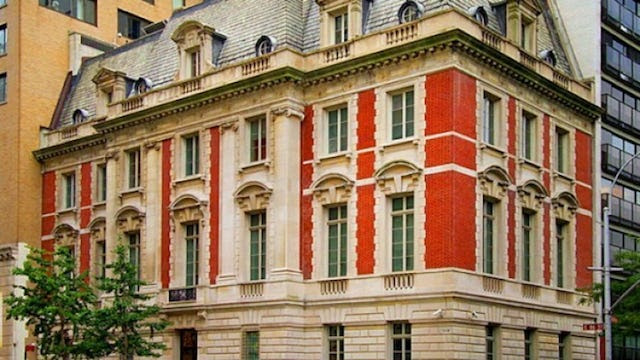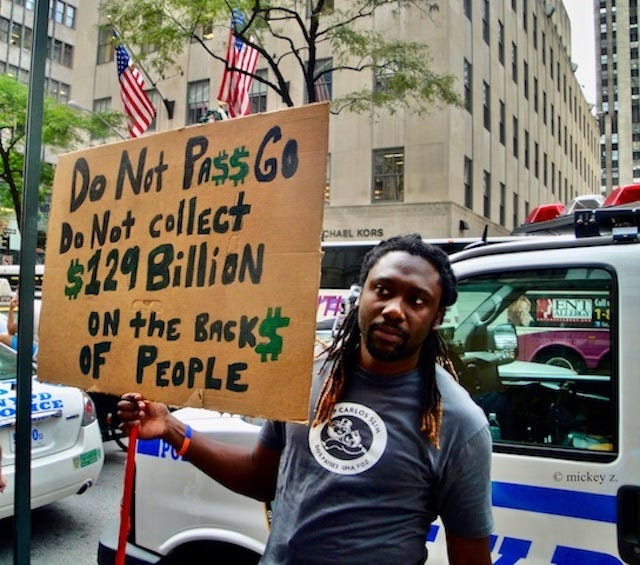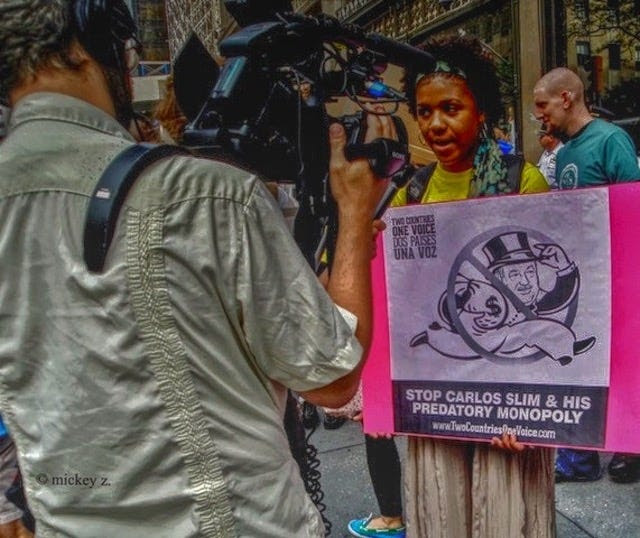We begin this long and winding ode on August 7, 2012 — a classic hot-and-humid Big Apple summer day. I was taking part in a demonstration called “Occupy Saks” and I came within an eyelash of being arrested by seven cops. I’ll get to that shortly.
For now, I’ll explain that the protest was ostensibly against a man named Carlos Slim who, despite such a cinematic moniker, is not a James Bond villain.
Slim is one of the world’s wealthiest humans with a fortune amassed by exploiting the poorest of the poor in Mexico through his telephone monopoly. For a short while, he was the only “richest man in the world” ever from a developing nation.
Slim was born in Mexico but is of Lebanese descent. He loves baseball, possesses at least 12 mansions across the globe, and owns part of the New York Times. At the time of the aforementioned protest, Slim was also the largest shareholder in Saks Fifth Avenue.

So, there we were. Occupy Wall Street, working with groups like Two Countries, One Voice, to spread “awareness” about Slim’s crimes. We had music and chanting and costumes and puppets and all that. We followed the well-worn script. This included handing out fliers to “educate” the masses.
Needless to say, most passers-by justifiably treated us as if we were just another NYC sidewalk nuisance. This brings me to reason #1 why current modes of street activism are counterproductive:
1. Street activism reinforces the negative public perception. To the average person, an activist is a fringe character. A fanatic. A wild-eyed zealot who sees the world in black-and-white terms. This perception exists for two primary reasons. Firstly, the corporate media works relentlessly and effectively to portray activism in a negative light. Secondly, many dissidents are wild-eyed zealots who see the world in black-and-white terms.
For example, I can remember (several times) standing out in sub-zero temperatures with a handful of others, protesting something or other. We’d felt so proud of ourselves. It was so dedicated of us to be risking our own health “for the cause.” When I’d share photos later (see reason #2) I’d use self-serving and self-deluding captions like: “This is what commitment looks like.”
Meanwhile, the people walking past such “protests” would look at us like we were, well, wild-eyed zealots. Some even yelled stuff like: “Get a life!” and “What’s wrong with you people?” I can see now how ridiculous we must’ve looked and how grandiose it was to assume we were doing anything even remotely productive. Multiply my experiences by thousands of events for thousands of “issues” across the country every single day and you have a self-fulfilling prophecy of failure.

Back to Saks: As the rally progressed, there were rumors of a protest flash mob soon to happen inside the store — which was ringed not only by Saks Fifth Avenue security but also by a large contingent of increasingly aggressive police.
(For the uninitiated, a flash mob is “a large public gathering at which people perform an unusual or seemingly random act and then disperse, typically organized by means of the internet or social media.”)
The cops and security in front of Saks were under strict rules to not let any “demonstrators” into the store. The legality of such a decree is questionable but hey, I’ve personally witnessed far more dubious “laws” made up on the spot during my activism days. Anyway, I wanted to get some photos of whatever might happen inside so I wandered around the corner to find a different entrance.
About halfway down 49th Street, I opened a door and walked inside — noticing two cops a few steps behind me. The entrance landed me in the hyper-expensive jewelry department. The saleswomen looked at me in my cargo shorts, sleeveless t-shirt, and backward Yankee cap and began surreptitiously signaling to me that I was being followed.
I regretted surrendering to my urge to get photos but I knew I could not do anything sudden at this point. So, I decided to walk casually but directly to the other side of Saks and exit ASAP.
The crowd of store detectives and cops following me grew with each step I took. I’d committed no crime but I knew this fact would not deter the NYPD. So, I stayed calm, enjoyed some air conditioning on a hot day, and began making my way through the eerie silence. As luck would have it, my “99%” button became unfastened from the small bag I had slung over my shoulder.
The pin dropped to the floor with a sonorous clang — echoing through the quiet section of the cavernous first floor. I reached down slowly, picked it up, and allowed myself a look around as I did. I was fully surrounded.
A uniformed cop — the shortest of the group by far — screamed at me: “Give me one fuckin’ reason why I shouldn’t take you in right now?” Some of the sales staff audibly gasped.
“Um,” I cooly replied, “because I haven’t given you any justification to do so. (pause) Besides I was just heading out anyway.”
I walked slowly — very slowly — toward the exit. The store detectives went back to looking for “demonstrators” while the seven cops stayed with me. The short cop got closer to me and barked: “Are you a demonstrator?”
“No,” I lied. “I just came inside to get some AC before I walked to the subway.”
“Why are you carrying a camera?”
“It’s New York City. Lots of people walk around taking photos.”
I had made it to the door without being stopped so I stepped back outside into the August humidity. All seven cops followed me. The one cop who had so far done all the talking positioned himself in front of me to block my way. I marveled at how emotionally committed he was to this performance.
“Are you a demonstrator?” he tried again. I shook my head “no” so he pointed to my bag.
“What’s in the bag?”
Never fluctuating from a non-threatening monotone, I replied: “You know as well as I do that I don’t have to tell you or show you.”
The cop did not like that legally-accurate reply. His hands balled into fists as he began shifting his weight from one foot to the other. I braced myself to be punched but he instead drilled me with a verbal barrage:
“What’s your button say? Are you a demonstrator? You know demonstrators are not allowed in here! Don’t bullshit me, I know why you’re here and what you’re up to. Are you a demonstrator?”

I did some quick thinking. In my youth, I’d dealt with many a cop and always managed to talk my way out of trouble — once when I was already in the back seat of a squad car! I glanced around at the other six cops and then back to Napoleon. They were all younger than me and relatively fit. But in my sleeveless shirt, I was clearly in better shape than any of them.
It struck me that I looked a lot more like the angry bro’s surrounding me than “the other” they are conditioned to fear, loathe, and oppress. So I decided to slip into the character I sometimes play while working in gyms.
“You know what,” I said with an exaggerated NYC accent, “you’d be bored if you looked in my bag anyway. I’ve got a towel because it’s so friggin’ hot out here, some water to stay hydrated, and a couple of power bars to keep my energy up.” (All true.)
Napoleon unfurled his fists and began to nod. “You mean, like nutrition and all?”
“Yeah,” I said. “You know how hot the subway platforms are? It can drain you.”
All seven cops were nodding now… trying to look like gym rats in the face of my spiel.
“So yeah,” I continued. “I’m not looking for any problems and I’ve got nothing to hide in my bag. You wanna look?”
“Nah,” Napoleon replied, “but just get moving.” The other cops lost interest in me as I walked off — without looking back.
Would I have evaded zip-ties if I were not a middle-aged white male? Yeah, right. But my entire interaction highlights reason #2 why current modes of street activism are counterproductive:
2. Street activism is more about cops, “symbolic” arrests, and social media. One of the more unfortunate yet enduring activist tendencies is to focus way more time and energy on challenging cops than challenging the dominant culture those cops are serving and protecting. So to all you “radicals”: If you really wanna goad cops into arresting you and/or scream “fuck the police,” please recognize that such gestures will do absolutely nothing to bring about serious, sustainable social change or to help lure more folks into activism. But it does lead to “epic” social media posts. A whole new breed of virtual “heroes” measure their “effectiveness” not by, um, being effective but instead by Facebook shares, Instagram likes, Twitter retweets, and donation page tallies.
For me, this silly game went on for a couple more years before I finally identified and rejected the cognitive dissonance. In those ensuing years, I ended up inside Saks Fifth Avenue once again when “Black Lives Matter” first became a thing. (Of course, the remnants of Occupy had lined up under the BLM banner and we did our best to virtue signal our way into your hearts and minds.)
It was December 2014 and the plan was to stage a “die-in” inside Saks during the holiday shopping crush. Dozens of activists (of all ethnicities) entered the store and pretended to be shoppers. When we got the signal, we were supposed to plop down onto the floor and pretend to be dead (see my photo above).
This was (somehow) supposed to represent the people of color who have been killed by law enforcement. I opted to not lie down because I wanted to get photos to document the action and well… I’d already had my fill of almost being arrested in this particular venue
Also, on some level, I could already recognize the ineffectually performative nature of this entire exercise. It would take a little while longer before I’d start saying this out loud and well… instantly, I lost about 90 percent of my “comrades.” The curtain had been pulled back and suddenly, the farce was exposed for what it is. This brings me to reason #3 why current modes of street activism are counterproductive:
3. Street activism gives us the illusion of being a threat. If street activism posed any threat to the status quo, they wouldn’t sell us permits to perform it. It’s all part of the wink-wink-nudge-nudge facade of the Land of the Free . The elites snicker as they agree: Let the silly activists chant and sing. It’ll create the impression we tolerate and even appreciate dissent. Then we can smirk and haughtily remind folks that “this isn’t allowed in many other countries, you know?” And if the protests appear like they may catch on, we release the big illusion.
. The elites snicker as they agree: Let the silly activists chant and sing. It’ll create the impression we tolerate and even appreciate dissent. Then we can smirk and haughtily remind folks that “this isn’t allowed in many other countries, you know?” And if the protests appear like they may catch on, we release the big illusion.
What’s the big illusion, you ask? Surely you know. We all know and we’re all complicit: It’s when the cops are told to viciously crack down on the hapless protestors. The disproportionate brutality of their response will appear to send a tacit message to the ineffectual activists: “You’re scaring us so we’re shutting you down.” Of course, this isn’t even close to true — but tell a group of social media-pumped sign holders that they’re dangerous, and you can be damn sure they won’t ever try tactics that might actually work. Why risk everything by escalating when our puppets and V for Vendetta masks have the State in a panic, right?
In the end, everyone imagines they’ve won:
- The activists have a slew of epic new arrest photos to share — “proof” that their tactics are threatening to the powers-that-shouldn’t-be
- The cops get to live out their video game fantasies by bashing their enemies in public with no repercussions
- The top 1% remain untouched, unfazed, unchallenged
Coda: The most recent time I went near Saks Fifth Avenue was in 2019 — not to go inside but to photograph their “iconic” holiday decorations.
The post BLM, OWS and the Folly of Street “Activism” first appeared on Dissident Voice.This post was originally published on Dissident Voice.

